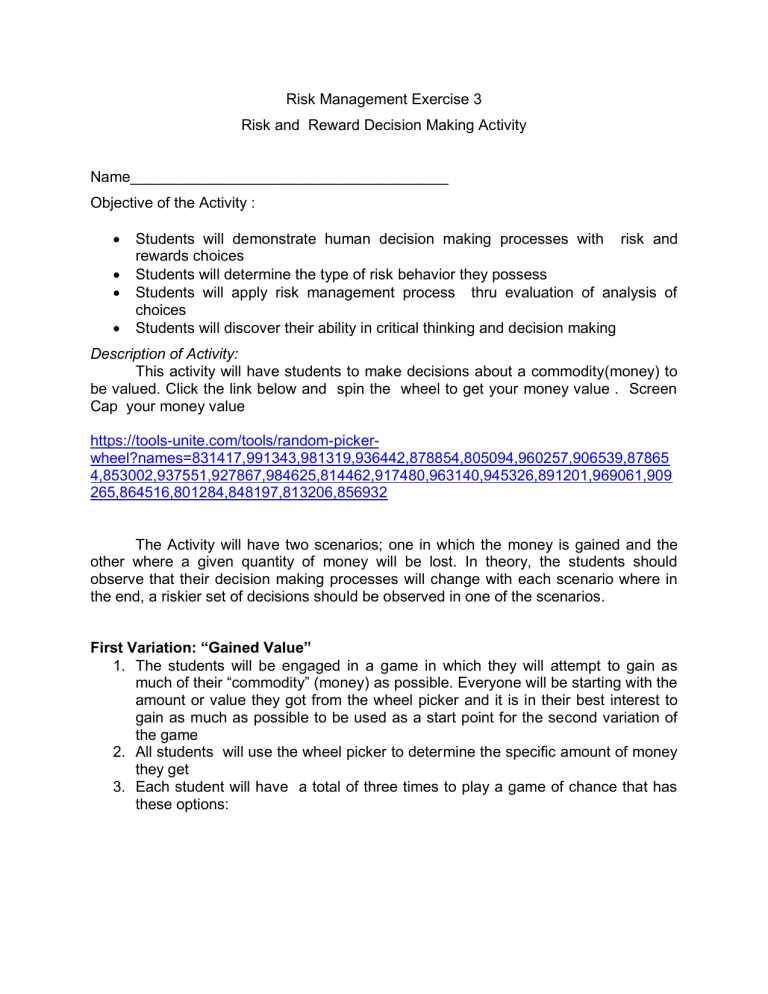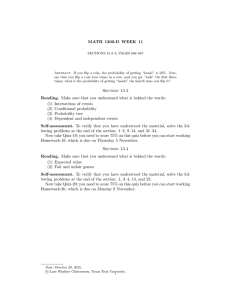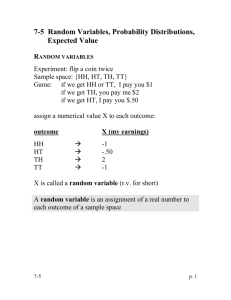
Risk Management Exercise 3 Risk and Reward Decision Making Activity Name______________________________________ Objective of the Activity : Students will demonstrate human decision making processes with risk and rewards choices Students will determine the type of risk behavior they possess Students will apply risk management process thru evaluation of analysis of choices Students will discover their ability in critical thinking and decision making Description of Activity: This activity will have students to make decisions about a commodity(money) to be valued. Click the link below and spin the wheel to get your money value . Screen Cap your money value https://tools-unite.com/tools/random-pickerwheel?names=831417,991343,981319,936442,878854,805094,960257,906539,87865 4,853002,937551,927867,984625,814462,917480,963140,945326,891201,969061,909 265,864516,801284,848197,813206,856932 The Activity will have two scenarios; one in which the money is gained and the other where a given quantity of money will be lost. In theory, the students should observe that their decision making processes will change with each scenario where in the end, a riskier set of decisions should be observed in one of the scenarios. First Variation: “Gained Value” 1. The students will be engaged in a game in which they will attempt to gain as much of their “commodity” (money) as possible. Everyone will be starting with the amount or value they got from the wheel picker and it is in their best interest to gain as much as possible to be used as a start point for the second variation of the game 2. All students will use the wheel picker to determine the specific amount of money they get 3. Each student will have a total of three times to play a game of chance that has these options: Here are the options: o Participate: Choose to flip the coin with positive or negative consequences (open flip coin in google search) (screen cap what you got on flip coin ) Heads will get you the same amount of what you have , thus doubling your total amount of money . Tails will get you nothing for your total amount of commodity o Not Participate: Receive a guaranteed payoff (50% of your money). 4. The students will play this game for a total of three times. 5. The total gain is then to be used in the second variation of the game. Amount of Money Participate st 1 Round 2nd Round 3rd Round Total money Total gain Not Participate Second Variation: Second Variation: “Loss Aversion” 1. This variation is essentially the opposite of the first variation. Instead of gaining as much of the “commodity” as possible, every student will attempt to save as much of the “commodity” as possible at the end of this variation. 2. The start point for this “loss aversion” will be the individual GAIN of each student from the first variation. 3. Each student will have a total of three times to play a game of chance that has these options: Here are the options: o Participate: Choose to flip the coin with positive or negative consequences (open flip coin in google search) (screen cap what you got on flip coin ) Heads will get you the same amount of what you have , thus doubling your total amount of money . Tails will get you nothing for your total amount of money o Not Participate: You will loss (50% of your gain ) Amount of Money Participate Not Participate st 1 Round 2nd Round 3rd Round Total money Total gain Assessment Questions: Answer must be not less than 5 sentences for each number , precise and brief . Use your own words and avoid copy pasting from the internet . 1. How did it feel to participate in the game where you gained money ? Can you explain your decision making process in this portion of the game? 2. Where your decision making processes similar or different when the rules of the game changed in the second variation? In other words, was there a differing amount of pressure when you could lose your money why not. 3. Do you believe there might be similarities or differences between you and your classmates in your decision making processes? 4. Do you believe there might differences between how males and females make these same decisions? 5. From a personal perspective, do you believe you might be predisposed to, or not to, gamble? Do you think this is genetically or environmentally determined? Explain your response.


